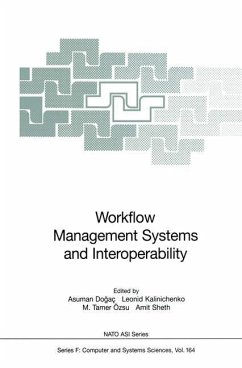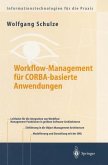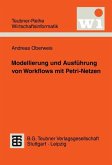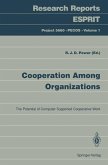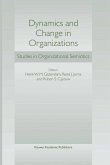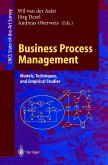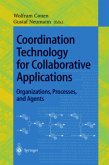Dogac
Workflow Management Systems and Interoperability
Herausgegeben:Dogac, Asuman; Kalinichenko, Leonid; Özsu, Tamer; Sheth, Amit
Dogac
Workflow Management Systems and Interoperability
Herausgegeben:Dogac, Asuman; Kalinichenko, Leonid; Özsu, Tamer; Sheth, Amit
- Gebundenes Buch
- Merkliste
- Auf die Merkliste
- Bewerten Bewerten
- Teilen
- Produkt teilen
- Produkterinnerung
- Produkterinnerung
Workflow management systems (WFMS) are enjoying increasing popular ity due to their ability to coordinate and streamline complex organizational processes within organizations of all sizes. Organizational processes are de scriptions of an organization's activities engineered to fulfill its mission such as completing a business contract or satisfying a specific customer request. Gaining control of these processes allows an organization to reengineer and improve each process or adapt them to changing requirements. The goal of WFMSs is to manage these organizational processes and coordinate their…mehr
Andere Kunden interessierten sich auch für
![Workflow-Management für COBRA-basierte Anwendungen Workflow-Management für COBRA-basierte Anwendungen]() Wolfgang SchulzeWorkflow-Management für COBRA-basierte Anwendungen54,99 €
Wolfgang SchulzeWorkflow-Management für COBRA-basierte Anwendungen54,99 €![Modellierung und Ausführung von Workflows mit Petri-Netzen Modellierung und Ausführung von Workflows mit Petri-Netzen]() Andreas OberweisModellierung und Ausführung von Workflows mit Petri-Netzen49,95 €
Andreas OberweisModellierung und Ausführung von Workflows mit Petri-Netzen49,95 €![Cooperation Among Organizations Cooperation Among Organizations]() Cooperation Among Organizations38,99 €
Cooperation Among Organizations38,99 €![Dynamics and Change in Organizations Dynamics and Change in Organizations]() Dynamics and Change in Organizations77,99 €
Dynamics and Change in Organizations77,99 €![Organizational Information Systems in the Context of Globalization Organizational Information Systems in the Context of Globalization]() Mikko Korpela / Ramiro Montealegre / Angeliki Poulymenakou (Hgg.)Organizational Information Systems in the Context of Globalization115,99 €
Mikko Korpela / Ramiro Montealegre / Angeliki Poulymenakou (Hgg.)Organizational Information Systems in the Context of Globalization115,99 €![Business Process Management Business Process Management]() Aalst, Wil, van der / Jörg Desel / Andreas Oberweis (eds.)Business Process Management39,99 €
Aalst, Wil, van der / Jörg Desel / Andreas Oberweis (eds.)Business Process Management39,99 €![Coordination Technology for Collaborative Applications Coordination Technology for Collaborative Applications]() ConenCoordination Technology for Collaborative Applications39,99 €
ConenCoordination Technology for Collaborative Applications39,99 €-
-
-
Workflow management systems (WFMS) are enjoying increasing popular ity due to their ability to coordinate and streamline complex organizational processes within organizations of all sizes. Organizational processes are de scriptions of an organization's activities engineered to fulfill its mission such as completing a business contract or satisfying a specific customer request. Gaining control of these processes allows an organization to reengineer and improve each process or adapt them to changing requirements. The goal of WFMSs is to manage these organizational processes and coordinate their execution. was demonstrated in the first half The high degree of interest in WFMSs of the 1990s by a significant increase in the number of commercial products (once estimated to about 250) and the estimated market size (in combined $2 billion in 1996. Ensuing maturity product sales and services) of about is demonstrated by consolidations during the last year. Ranging from mere e-mail based calendar tools and flow charting tools to very sophisticated inte grated development environments for distributed enterprise-wide applications and systems to support programming in the large, these products are finding an eager market and opening up important research and development op portunities. In spite of their early success in the market place, however, the current generation of systems can benefit from further research and develop ment, especially for increasingly complex and mission-critical applications.
Produktdetails
- Produktdetails
- Nato ASI Subseries F: 164
- Verlag: Springer / Springer Berlin Heidelberg / Springer, Berlin
- Artikelnr. des Verlages: 10648795, 978-3-540-64411-8
- 1998.
- Seitenzahl: 548
- Erscheinungstermin: 17. September 1998
- Englisch
- Abmessung: 241mm x 160mm x 34mm
- Gewicht: 892g
- ISBN-13: 9783540644118
- ISBN-10: 3540644113
- Artikelnr.: 09251998
- Herstellerkennzeichnung
- Springer-Verlag GmbH
- Tiergartenstr. 17
- 69121 Heidelberg
- ProductSafety@springernature.com
- Nato ASI Subseries F: 164
- Verlag: Springer / Springer Berlin Heidelberg / Springer, Berlin
- Artikelnr. des Verlages: 10648795, 978-3-540-64411-8
- 1998.
- Seitenzahl: 548
- Erscheinungstermin: 17. September 1998
- Englisch
- Abmessung: 241mm x 160mm x 34mm
- Gewicht: 892g
- ISBN-13: 9783540644118
- ISBN-10: 3540644113
- Artikelnr.: 09251998
- Herstellerkennzeichnung
- Springer-Verlag GmbH
- Tiergartenstr. 17
- 69121 Heidelberg
- ProductSafety@springernature.com
Workflow Management: State of the Art Versus State of the Products.- 1. Introduction.- 1.1 Background.- 1.2 Workflow Systems.- 2. Workflow Products.- 2.1 Current Status.- 2.2 Industry Trends.- 3. Workflow Research.- 3.1 Transactional Workflow.- 3.2 Distributed Workflow Execution.- 3.3 Dynamic Workflow.- 4. Conclusions.- A Distributed Workflow and Product Data Management Application for the Construction of Large Scale Scientific Apparatus.- 1. Introduction.- 2. Background.- 3. General Architecture and Design.- 4. Data Distribution Philosophy.- 5. Workflow Management in CRISTAL.- 6. Workflow System Design.- 7. Coping with Dynamic Change.- 8. Conclusions and Project Status.- Workflow Applications to Research Agenda: Scalable and Dynamic Work Coordination and Collaboration Systems.- 1. Introduction.- 2. Agenda for Current and Future Research.- 3. Application Driven Motivation and Requirements.- 3.1 Scalability.- 3.2 Adaptive and Dynamic Workflows.- 3.3 Integral Support for Collaboration.- 4. METEOR2 WFMS and its Support for Scalability.- 4.1 Workflow Design and Application Building in METEOR2.- 4.2 The Runtime Code Generator.- 4.3 METEOR2 Runtime Support System.- 4.4 The ORBWork Workflow Enactment System.- 4.5 Scalability of ORBWork.- 5. New Challenges to Support Dynamic and Collaborative Work.- 5.1 Work Coordination and Collaboration System.- 5.2 WCCS Design.- 5.3 WCCS Architecture.- 5.4 Work Coordination and Collaboration Engine.- 6. Conclusions.- Design and Implementation of a Distributed Workflow Management System: METUFIow.- 1. Introduction.- 2. The Process Model and the METUFIow Definition Language:.- MFDL.- 3. Guard Generation for Distributed Scheduling.- 3.1 Semantics of the Block Types Using ACTA Formalism.- 3.2 Guard Construction Steps.- 4. METUFIow Architecture.-5. Guard Handlers in METUFIow.- 6. Task Handling in METUFIow.- 7. Worklist Management in METUFIow.- 8. History Management in METUFIow.- 9. OTS Based Transaction Manager.- 10. Correctness Issues in METUFIow.- 10.1 Concurrency Control in METUFIow.- 10.2 Future Considerations for Concurrency Control in METUFIow.- 11. Conclusions.- HP Workflow Research: Past, Present, and Future.- 1. Introduction.- 2. Stage 1: Advanced Feature Enhancements.- 3. Stage 2: Enterprise Business Process Management System.- 3.1 The Requirements.- 3.2 OpenPM Overview.- 3.3 OpenPM Application Development Facilities.- 3.4 An Application Example.- 4. Stage 3: Internet-Based Service Process Management System.- 4.1 FlowJet Overview.- Reducing Escalation-Related Costs in WFMSs.- 1. Introduction.- 2. System Model.- 2.1 Workflow Schema.- 2.2 Deadlines and Escalations.- 2.3 Assumptions.- 3. Dynamic Deadline Adjustment (DDA).- 4. Preemptive Escalation.- 5. Experimental Evaluation.- 5.1 Simulation Model.- 5.2 Experimental Setup.- 5.3 Simulation Results.- 6. Related Work.- 7. Conclusions.- The Workflow Management System Panta Rhei.- 1. Introduction.- 2. The Concepts of Panta Rhei.- 2.1 Classification of Workflows.- 2.2 Basic Concepts.- 2.3 Additional Features.- 2.4 Open Architecture.- 3. Workflow Description Language.- 3.1 Workflow Specification.- 3.2 Execution of WDL.- 4. Architecture and Implementation.- 5. Conclusions.- The WASA Approach to Workflow Management for Scientific Applications.- 1. Introduction.- 2. Workflow Modeling.- 2.1 Workflow Modeling in Business Applications.- 2.2 Workflow Modeling in Scientific Applications.- 2.3 Case Study: Scientific Workflows in Molecular Biology.- 3. Dynamic Change Operations.- 3.1 Anticipated Dynamic Change.- 3.2 Ad-hoc Dynamic Change.- 3.3 Related Work on Dynamic Change.- 4. The WASA Architecture.- 4.1 The WASA Layers.- 5. The WASA Prototype.- 5.1 General Considerations.- 5.2 System Architecture.- 6. Conclusions and Future Work.- Security Enforcement in Activity Management Systems.- 1. Introduction.- 1.1 Related Work.- 2. Secure CapBasED-AMS.- 2.1 Architecture of Secure CapBasED-AMS.- 3. Security Requirements for Activity Specification and Decomposition.- 3.1 Security Control in Activity Specification.- 3.2 Security Constraints Specification.- 4. Framework for Activity Execution.- 4.1 Activity Graph.- 4.2 ECA Rules.- 4.3 Activity Coordinator.- 4.4 Communication Between the Activity Coordinator and PSAs.- 4.5 Task and Event Logging.- 4.6 Exception Condition Handling and Error Recovery.- 5. Security Enforcement During Task Execution.- 5.1 Security Policy Decider and Secure PSA.- 5.2 Enforcement of Task Oriented Modeling of Security.- 6. Open Problems and Summary.- Towards a Platform for Distributed Application Development.- 1. Introduction.- 2. Motivation.- 2.1 Application Example.- 2.2 Software Solutions.- 2.3 Kernel Functionality for Distributed Systems.- 3. The OPERA Kernel.- 3.1 Architecture.- 3.2 Process Management: Model.- 3.3 Transactional Execution Guarantees.- 3.4 Availability and Scalability.- 3.5 Externalized Database Functionality.- 4. Application Examples.- 4.1 High-Level Object Management (HLOM).- 4.2 Distributed Object Management (DOM).- 5. Conclusions.- The Integration of Workflow Systems and Collaboration Tools.- 1. Introduction.- 2. Concerns and Theoretical Foundations.- 2.1 Coordination Versus Collaboration.- 2.2 The Situated Nature of Work.- 2.3 Organizational Structures and Flows.- 2.4 Empirical Evidence.- 3. Orchestra: a Testbed Environment.- 3.1 Objectives.- 3.2 Participants and Activities.- 4. Workflow Systems and Technology.- 4.1 A Sample of Workflow Systems.- 4.2 Groupware Environments and Workflow Support Mechanisms.- 4.3 Workflow Modeling Approaches.- 4.4 The Workflow Management Coalition.- 5. Collaboration Approaches and Technologies.- 5.1 Collaboration Technology.- 5.2 Techniques for Group Decision and Collaboration.- 5.3 Decision Models.- 6. The Integrative Approaches.- 6.1 Identifying Exceptions.- 6.2 Collaboration as a Handler for Coordination Problems.- 6.3 Beyond Exceptions.- 7. Conclusions.- Interoperability in Large-Scale Distributed Information Delivery Systems.- 1. Introduction.- 2. Architectural Issues.- 2.1 Multidatabase-Based Paradigm.- 2.2 Mediator-Based Paradigm.- 3. Technical Issues.- 3.1 Data Delivery Protocols.- 3.2 Data Delivery Modes.- 3.3 Data Delivery Frequency.- 3.4 General Remarks.- 4. Overview of Some Existing Projects.- 4.1 Broadcast Disks Approach to Information Dissemination.- 4.2 Carnot.- 4.3 DIOM.- 4.4 DISCO.- 4.5 InfoSleuth.- 4.6 MIND.- 4.7 TSIMMIS.- 4.8 Comparison with Respect to Data Delivery Capabilities.- 5. Enabling Technology for Interoperability.- 5.1 CORBA.- 5.2 COM/OLE.- 6. AURORA and its Application to Electronic Commerce.- 6.1 A Motivating Example:Virtual Catalogs in Electronic Commerce.- 6.2 Homogenization and Integration Mediators:A 2-tier Mediation Model.- 6.3 AURORA Mediators as Distributed Components.- 6.4 AURORA Mediator Development Workbench.- 6.5 Homogenization Mediators.- 6.6 AURORA Integration Mediators.- 6.7 Constructing Virtual Catalogs with AURORA.- 7. Conclusion.- Enterprise-Wide Workflow Management Based on State and Activity Charts.- 1. Introduction.- 2. Requirements on Workflow Specification Methods.- 3. Formal Methods for Workflow Specification.- 4. Workflow Specification with State and Activity Charts.- 4.1Introduction to State and Activity Charts.- 4.2 Design Methodology for Workflow Specifications.- 5. Utilizing Tools for Formal Verification.- 5.1 Workflow Properties.- 5.2 Specification of Workflow Properties.- 5.3 Model Checking.- 6. Distributed Workflow Execution.- 6.1 Partitioning of State and Activity Charts.- 6.2 Correctness of the Partitioning.- 6.3 Synchronization.- 6.4 Fault Tolerance.- 7. Conclusions.- Transactional Support for Cooperative Applications.- 1. Introduction.- 2. Transactional Support for Cooperative Applications.- 2.1 Characteristics of Cooperative Applications.- 2.2 Motivating Example.- 2.3 Requirements for a Cooperative Transaction Model.- 2.4 Approaches to Support Cooperative Work.- 3. Towards a Cooperative Transaction Model.- 3.1 Semantics-Based Approaches.- 3.2 Check-out/Check-in, Versioning, and Workspaces.- 3.3 Split/Join Transactions and Delegation.- 3.4 Group-Oriented Approaches and Transactional Workflow.- 4. The TRANSCOOP Approach.- 4.1 Overview of the COACT Transaction Model.- 4.2 Formalization of the COACT Transaction Model.- 4.3 Example of History Merging.- 4.4 Organizing the Work Process.- 4.5 Prototype Implementation.- 4.6 Discussion and Relationship to Other Transaction Models.- 5. Conclusions.- Migrating Workflows.- 1. Introduction.- 2. Migrating Workflow Model.- 3. Migrating Workflow - An Example.- 4. Enactment Mechanisms for the Migrating Workflows.- 4.1 Execution System Guarantees.- 4.2 Architectural Considerations.- 4.3 Security Considerations.- 4.4 User Interfaces.- 4.5 Networking Infrastructure.- 5. Workflow Administration Issues.- 5.1 Process Modeling.- 5.2 Workflow Specification.- 5.3 Administration of Migrating Workflows.- 6. Discussion and Summary.- Technology and Tools for Comprehensive Business Process Lifecycle Management.- 1. Introduction.- 2. Characterizing Business Processes.- 3. Traditional Business Process Lifecycle Management.- 3.1 Capturing Process Definition.- 3.2 Reengineering a Process.- 3.3 Implementing a Process.- 3.4 Performing Continuous Process Improvement.- 4. Technology and Tools for Business Process Lifecycle Management.- 4.1 Business Process Modeling Technology and Tools.- 4.2 Workflow Management Technology and Systems.- 4.3 Interoperability Between BPMTs and WFMSs.- 5. Role of BPMT and WFMS Technology.- in the Business Process Lifecycle.- 5.1 Capturing Process Definition.- 5.2 Reengineering a Process.- 5.3 Implementing a Process.- 5.4 Performing Continuous Process Improvement.- 6. Evaluation of Current Business Process Modeling Technology.- 6.1 Business Process Models and Methodologies.- 6.2 Business Process Analysis.- 6.3 Business Process Simulation.- 6.4 Business Process Evaluation Reports and Documentation.- 7. Evaluation of Current Workflow Management Technology.- 7.1 Workflow Model.- 7.2 Dataflow.- 7.3 Workflow Process Definition Tools.- 7.4 Analysis, Simulation, and Animation Tools.- 7.5 Workflow Monitoring and Tracking Tools.- 7.6 Basic WFMS Infrastructure: Architecture, GUIs, and APIs.- 7.7 Advanced WFMS Infrastructure:Distribution, Scalability, and Component Redundancy.- 7.8 Interoperability Among WFMSs and Heterogeneous Applications.- 7.9 Concurrency Control, Recovery, and Advanced Transactions.- 8. Evaluation of Current BPMTs and WFMSs Integration.- 8.1 Loose Integration.- 8.2 Tight Integration.- 8.3 Reverse Integration.- 9. Critical Success Factors and Conclusion.- Recent Trends in Workflow Management Products, Standards and Research.- 1. Introduction.- 2. Market Trends and Business Considerations.- 3. Workflow Standards.- 4. Technical Trends.- 5. Research Projects.- 6. Conclusions.- Kerem - Reasoning About the Design of Partially Cooperative Systems.- 1. Introduction and Motivation.- 1.1 Partially Cooperative Systems.- 1.2 The Need for Reasoning.- 1.3 Outline.- 2. The Modeling Tool.- 2.1 The Basic Primitives.- 2.2 The Event Perspective.- 2.3 The Task Perspective.- 2.4 The Entity Perspective.- 2.5 The Actor Perspective.- 2.6 An Example.- 3. Reasoning About a Design Model.- 3.1 Diagnostics.- 3.2 Change Evaluation.- 3.3 Query System.- 4. Conclusion.- 4.1 Related Work.- 4.2 Concluding Remarks.- Workflow Technologies Meet the Internet.- 1. Introduction.- 2. Open Workflow Clients.- 3. Workflow Component Servers.- 4. A Transactional Model for Cooperative Business Processes.- 5. Conclusions.- Workflow Reuse and Semantic Interoperation Issues.- 1. Introduction.- 2. Related Research and Technological Developments.- 3. Conventional Versus Component-Based Information Systems Development Life Cycles.- 4. Semantic Interoperation Reasoning Approach.- 4.1 The SIR Framework Models.- 4.2 Design with Reuse.- 5. Specification Refinement.- 6. Type Specification Reuse and Compositions.- 6.1 Most Common Reduct.- 6.2 Process of Common Reduct Detection.- 6.3 Construction of Concretizing Types and Views.- 7. Ontological Relevance of Specifications.- 7.1 Tight Ontological Relevance.- 7.2 Loose Ontological Relevance.- 8. A Uniform Script-Based Multiactivity Framework.- 8.1 An Overview of the Relevant SYNTHESIS Language Features.- 8.2 Script Types.- 8.3 Capabilities of the Canonical Model.- 8.4 An Example of a Funding Agency Multiactivity Specification.- 8.5 Pre-existing Workflow Specifications.- 9. Workflow Design with Reuse.- 9.1 An Introduction into the Basic Process Algebra with Iteration.- 9.2 Script Processes.- 9.3 Refinement of Scripts.- 9.4 Script Type Reducts.- 9.5 Process of a Script Design with Reuse.- 9.6 Example of the Most Common Reduct Identification.- 10. Conclusion.- A. Definition of a Script Type.- B. Interpretation of Stallware in the Canonical Workflow Model.- C. Interpretation of IBM FlowMark in the Canonical Workflow Model.- References.
Workflow Management: State of the Art Versus State of the Products.- 1. Introduction.- 1.1 Background.- 1.2 Workflow Systems.- 2. Workflow Products.- 2.1 Current Status.- 2.2 Industry Trends.- 3. Workflow Research.- 3.1 Transactional Workflow.- 3.2 Distributed Workflow Execution.- 3.3 Dynamic Workflow.- 4. Conclusions.- A Distributed Workflow and Product Data Management Application for the Construction of Large Scale Scientific Apparatus.- 1. Introduction.- 2. Background.- 3. General Architecture and Design.- 4. Data Distribution Philosophy.- 5. Workflow Management in CRISTAL.- 6. Workflow System Design.- 7. Coping with Dynamic Change.- 8. Conclusions and Project Status.- Workflow Applications to Research Agenda: Scalable and Dynamic Work Coordination and Collaboration Systems.- 1. Introduction.- 2. Agenda for Current and Future Research.- 3. Application Driven Motivation and Requirements.- 3.1 Scalability.- 3.2 Adaptive and Dynamic Workflows.- 3.3 Integral Support for Collaboration.- 4. METEOR2 WFMS and its Support for Scalability.- 4.1 Workflow Design and Application Building in METEOR2.- 4.2 The Runtime Code Generator.- 4.3 METEOR2 Runtime Support System.- 4.4 The ORBWork Workflow Enactment System.- 4.5 Scalability of ORBWork.- 5. New Challenges to Support Dynamic and Collaborative Work.- 5.1 Work Coordination and Collaboration System.- 5.2 WCCS Design.- 5.3 WCCS Architecture.- 5.4 Work Coordination and Collaboration Engine.- 6. Conclusions.- Design and Implementation of a Distributed Workflow Management System: METUFIow.- 1. Introduction.- 2. The Process Model and the METUFIow Definition Language:.- MFDL.- 3. Guard Generation for Distributed Scheduling.- 3.1 Semantics of the Block Types Using ACTA Formalism.- 3.2 Guard Construction Steps.- 4. METUFIow Architecture.-5. Guard Handlers in METUFIow.- 6. Task Handling in METUFIow.- 7. Worklist Management in METUFIow.- 8. History Management in METUFIow.- 9. OTS Based Transaction Manager.- 10. Correctness Issues in METUFIow.- 10.1 Concurrency Control in METUFIow.- 10.2 Future Considerations for Concurrency Control in METUFIow.- 11. Conclusions.- HP Workflow Research: Past, Present, and Future.- 1. Introduction.- 2. Stage 1: Advanced Feature Enhancements.- 3. Stage 2: Enterprise Business Process Management System.- 3.1 The Requirements.- 3.2 OpenPM Overview.- 3.3 OpenPM Application Development Facilities.- 3.4 An Application Example.- 4. Stage 3: Internet-Based Service Process Management System.- 4.1 FlowJet Overview.- Reducing Escalation-Related Costs in WFMSs.- 1. Introduction.- 2. System Model.- 2.1 Workflow Schema.- 2.2 Deadlines and Escalations.- 2.3 Assumptions.- 3. Dynamic Deadline Adjustment (DDA).- 4. Preemptive Escalation.- 5. Experimental Evaluation.- 5.1 Simulation Model.- 5.2 Experimental Setup.- 5.3 Simulation Results.- 6. Related Work.- 7. Conclusions.- The Workflow Management System Panta Rhei.- 1. Introduction.- 2. The Concepts of Panta Rhei.- 2.1 Classification of Workflows.- 2.2 Basic Concepts.- 2.3 Additional Features.- 2.4 Open Architecture.- 3. Workflow Description Language.- 3.1 Workflow Specification.- 3.2 Execution of WDL.- 4. Architecture and Implementation.- 5. Conclusions.- The WASA Approach to Workflow Management for Scientific Applications.- 1. Introduction.- 2. Workflow Modeling.- 2.1 Workflow Modeling in Business Applications.- 2.2 Workflow Modeling in Scientific Applications.- 2.3 Case Study: Scientific Workflows in Molecular Biology.- 3. Dynamic Change Operations.- 3.1 Anticipated Dynamic Change.- 3.2 Ad-hoc Dynamic Change.- 3.3 Related Work on Dynamic Change.- 4. The WASA Architecture.- 4.1 The WASA Layers.- 5. The WASA Prototype.- 5.1 General Considerations.- 5.2 System Architecture.- 6. Conclusions and Future Work.- Security Enforcement in Activity Management Systems.- 1. Introduction.- 1.1 Related Work.- 2. Secure CapBasED-AMS.- 2.1 Architecture of Secure CapBasED-AMS.- 3. Security Requirements for Activity Specification and Decomposition.- 3.1 Security Control in Activity Specification.- 3.2 Security Constraints Specification.- 4. Framework for Activity Execution.- 4.1 Activity Graph.- 4.2 ECA Rules.- 4.3 Activity Coordinator.- 4.4 Communication Between the Activity Coordinator and PSAs.- 4.5 Task and Event Logging.- 4.6 Exception Condition Handling and Error Recovery.- 5. Security Enforcement During Task Execution.- 5.1 Security Policy Decider and Secure PSA.- 5.2 Enforcement of Task Oriented Modeling of Security.- 6. Open Problems and Summary.- Towards a Platform for Distributed Application Development.- 1. Introduction.- 2. Motivation.- 2.1 Application Example.- 2.2 Software Solutions.- 2.3 Kernel Functionality for Distributed Systems.- 3. The OPERA Kernel.- 3.1 Architecture.- 3.2 Process Management: Model.- 3.3 Transactional Execution Guarantees.- 3.4 Availability and Scalability.- 3.5 Externalized Database Functionality.- 4. Application Examples.- 4.1 High-Level Object Management (HLOM).- 4.2 Distributed Object Management (DOM).- 5. Conclusions.- The Integration of Workflow Systems and Collaboration Tools.- 1. Introduction.- 2. Concerns and Theoretical Foundations.- 2.1 Coordination Versus Collaboration.- 2.2 The Situated Nature of Work.- 2.3 Organizational Structures and Flows.- 2.4 Empirical Evidence.- 3. Orchestra: a Testbed Environment.- 3.1 Objectives.- 3.2 Participants and Activities.- 4. Workflow Systems and Technology.- 4.1 A Sample of Workflow Systems.- 4.2 Groupware Environments and Workflow Support Mechanisms.- 4.3 Workflow Modeling Approaches.- 4.4 The Workflow Management Coalition.- 5. Collaboration Approaches and Technologies.- 5.1 Collaboration Technology.- 5.2 Techniques for Group Decision and Collaboration.- 5.3 Decision Models.- 6. The Integrative Approaches.- 6.1 Identifying Exceptions.- 6.2 Collaboration as a Handler for Coordination Problems.- 6.3 Beyond Exceptions.- 7. Conclusions.- Interoperability in Large-Scale Distributed Information Delivery Systems.- 1. Introduction.- 2. Architectural Issues.- 2.1 Multidatabase-Based Paradigm.- 2.2 Mediator-Based Paradigm.- 3. Technical Issues.- 3.1 Data Delivery Protocols.- 3.2 Data Delivery Modes.- 3.3 Data Delivery Frequency.- 3.4 General Remarks.- 4. Overview of Some Existing Projects.- 4.1 Broadcast Disks Approach to Information Dissemination.- 4.2 Carnot.- 4.3 DIOM.- 4.4 DISCO.- 4.5 InfoSleuth.- 4.6 MIND.- 4.7 TSIMMIS.- 4.8 Comparison with Respect to Data Delivery Capabilities.- 5. Enabling Technology for Interoperability.- 5.1 CORBA.- 5.2 COM/OLE.- 6. AURORA and its Application to Electronic Commerce.- 6.1 A Motivating Example:Virtual Catalogs in Electronic Commerce.- 6.2 Homogenization and Integration Mediators:A 2-tier Mediation Model.- 6.3 AURORA Mediators as Distributed Components.- 6.4 AURORA Mediator Development Workbench.- 6.5 Homogenization Mediators.- 6.6 AURORA Integration Mediators.- 6.7 Constructing Virtual Catalogs with AURORA.- 7. Conclusion.- Enterprise-Wide Workflow Management Based on State and Activity Charts.- 1. Introduction.- 2. Requirements on Workflow Specification Methods.- 3. Formal Methods for Workflow Specification.- 4. Workflow Specification with State and Activity Charts.- 4.1Introduction to State and Activity Charts.- 4.2 Design Methodology for Workflow Specifications.- 5. Utilizing Tools for Formal Verification.- 5.1 Workflow Properties.- 5.2 Specification of Workflow Properties.- 5.3 Model Checking.- 6. Distributed Workflow Execution.- 6.1 Partitioning of State and Activity Charts.- 6.2 Correctness of the Partitioning.- 6.3 Synchronization.- 6.4 Fault Tolerance.- 7. Conclusions.- Transactional Support for Cooperative Applications.- 1. Introduction.- 2. Transactional Support for Cooperative Applications.- 2.1 Characteristics of Cooperative Applications.- 2.2 Motivating Example.- 2.3 Requirements for a Cooperative Transaction Model.- 2.4 Approaches to Support Cooperative Work.- 3. Towards a Cooperative Transaction Model.- 3.1 Semantics-Based Approaches.- 3.2 Check-out/Check-in, Versioning, and Workspaces.- 3.3 Split/Join Transactions and Delegation.- 3.4 Group-Oriented Approaches and Transactional Workflow.- 4. The TRANSCOOP Approach.- 4.1 Overview of the COACT Transaction Model.- 4.2 Formalization of the COACT Transaction Model.- 4.3 Example of History Merging.- 4.4 Organizing the Work Process.- 4.5 Prototype Implementation.- 4.6 Discussion and Relationship to Other Transaction Models.- 5. Conclusions.- Migrating Workflows.- 1. Introduction.- 2. Migrating Workflow Model.- 3. Migrating Workflow - An Example.- 4. Enactment Mechanisms for the Migrating Workflows.- 4.1 Execution System Guarantees.- 4.2 Architectural Considerations.- 4.3 Security Considerations.- 4.4 User Interfaces.- 4.5 Networking Infrastructure.- 5. Workflow Administration Issues.- 5.1 Process Modeling.- 5.2 Workflow Specification.- 5.3 Administration of Migrating Workflows.- 6. Discussion and Summary.- Technology and Tools for Comprehensive Business Process Lifecycle Management.- 1. Introduction.- 2. Characterizing Business Processes.- 3. Traditional Business Process Lifecycle Management.- 3.1 Capturing Process Definition.- 3.2 Reengineering a Process.- 3.3 Implementing a Process.- 3.4 Performing Continuous Process Improvement.- 4. Technology and Tools for Business Process Lifecycle Management.- 4.1 Business Process Modeling Technology and Tools.- 4.2 Workflow Management Technology and Systems.- 4.3 Interoperability Between BPMTs and WFMSs.- 5. Role of BPMT and WFMS Technology.- in the Business Process Lifecycle.- 5.1 Capturing Process Definition.- 5.2 Reengineering a Process.- 5.3 Implementing a Process.- 5.4 Performing Continuous Process Improvement.- 6. Evaluation of Current Business Process Modeling Technology.- 6.1 Business Process Models and Methodologies.- 6.2 Business Process Analysis.- 6.3 Business Process Simulation.- 6.4 Business Process Evaluation Reports and Documentation.- 7. Evaluation of Current Workflow Management Technology.- 7.1 Workflow Model.- 7.2 Dataflow.- 7.3 Workflow Process Definition Tools.- 7.4 Analysis, Simulation, and Animation Tools.- 7.5 Workflow Monitoring and Tracking Tools.- 7.6 Basic WFMS Infrastructure: Architecture, GUIs, and APIs.- 7.7 Advanced WFMS Infrastructure:Distribution, Scalability, and Component Redundancy.- 7.8 Interoperability Among WFMSs and Heterogeneous Applications.- 7.9 Concurrency Control, Recovery, and Advanced Transactions.- 8. Evaluation of Current BPMTs and WFMSs Integration.- 8.1 Loose Integration.- 8.2 Tight Integration.- 8.3 Reverse Integration.- 9. Critical Success Factors and Conclusion.- Recent Trends in Workflow Management Products, Standards and Research.- 1. Introduction.- 2. Market Trends and Business Considerations.- 3. Workflow Standards.- 4. Technical Trends.- 5. Research Projects.- 6. Conclusions.- Kerem - Reasoning About the Design of Partially Cooperative Systems.- 1. Introduction and Motivation.- 1.1 Partially Cooperative Systems.- 1.2 The Need for Reasoning.- 1.3 Outline.- 2. The Modeling Tool.- 2.1 The Basic Primitives.- 2.2 The Event Perspective.- 2.3 The Task Perspective.- 2.4 The Entity Perspective.- 2.5 The Actor Perspective.- 2.6 An Example.- 3. Reasoning About a Design Model.- 3.1 Diagnostics.- 3.2 Change Evaluation.- 3.3 Query System.- 4. Conclusion.- 4.1 Related Work.- 4.2 Concluding Remarks.- Workflow Technologies Meet the Internet.- 1. Introduction.- 2. Open Workflow Clients.- 3. Workflow Component Servers.- 4. A Transactional Model for Cooperative Business Processes.- 5. Conclusions.- Workflow Reuse and Semantic Interoperation Issues.- 1. Introduction.- 2. Related Research and Technological Developments.- 3. Conventional Versus Component-Based Information Systems Development Life Cycles.- 4. Semantic Interoperation Reasoning Approach.- 4.1 The SIR Framework Models.- 4.2 Design with Reuse.- 5. Specification Refinement.- 6. Type Specification Reuse and Compositions.- 6.1 Most Common Reduct.- 6.2 Process of Common Reduct Detection.- 6.3 Construction of Concretizing Types and Views.- 7. Ontological Relevance of Specifications.- 7.1 Tight Ontological Relevance.- 7.2 Loose Ontological Relevance.- 8. A Uniform Script-Based Multiactivity Framework.- 8.1 An Overview of the Relevant SYNTHESIS Language Features.- 8.2 Script Types.- 8.3 Capabilities of the Canonical Model.- 8.4 An Example of a Funding Agency Multiactivity Specification.- 8.5 Pre-existing Workflow Specifications.- 9. Workflow Design with Reuse.- 9.1 An Introduction into the Basic Process Algebra with Iteration.- 9.2 Script Processes.- 9.3 Refinement of Scripts.- 9.4 Script Type Reducts.- 9.5 Process of a Script Design with Reuse.- 9.6 Example of the Most Common Reduct Identification.- 10. Conclusion.- A. Definition of a Script Type.- B. Interpretation of Stallware in the Canonical Workflow Model.- C. Interpretation of IBM FlowMark in the Canonical Workflow Model.- References.

